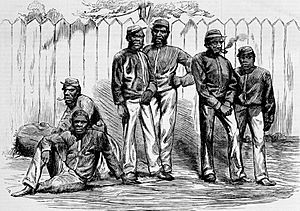Aboriginal tracker facts for kids
Aboriginal trackers were skilled Indigenous people who helped European settlers explore Australia. They were very good at finding clues in the environment. Their amazing tracking skills helped settlers find food and water. Trackers also helped find missing people and even catch outlaws known as bushrangers.
The first time Europeans used Aboriginal trackers was in 1791. Watkin Tench asked Eora men Colbee and Balloderry to find a path to the Hawkesbury River. In 1795, an Aboriginal guide helped Henry Hacking find lost cattle. In 1802, Dharawal and Gandangara men helped Ensign Francis Barrallier explore the Blue Mountains. Many explorers, farmers, and police used their help. For example, in 1834, two trackers named Mogo and Mollydobbin found a lost five-year-old boy near Fremantle. They tracked him for over ten hours through tough bushland. Another famous tracker, Dick-a-Dick, found the Duff children in 1864. They had been lost for nine days in Wimmera.
Contents
How Trackers Followed Clues
A famous tracker named Mitamirri once explained how he tracked. He said, "I never bend down low, just walk slow round and round until I see more." This shows how carefully they observed their surroundings.
In 1845, Edward Stone Parker, a Protector of Aborigines in Victoria, wrote about a tracking case. Footprints of five men were tracked by the Jajowurrong people. They followed the tracks to open country south of Mount Macedon. There, they met another man who described the group they were tracking. This helped the authorities understand what happened.
The New South Wales Police Force started hiring Aboriginal trackers from 1850. They wanted a tracker for each police area. By 1867, 52 Aboriginal trackers worked for the police. They were paid about 2 shillings and 6 pence a day. This was about £3 17s 6d per month.
During a time when bushrangers were very active, three Aboriginal trackers helped catch the Clarke brothers. This happened in 1867 near Braidwood. Tracker Sir Watkin Wynne led the police to their location. He was badly hurt during the capture and lost an arm. He received £120 for his bravery. Two other trackers, George Emmott and Thomas, also helped and received smaller awards. George Emmott had also helped arrest another gang member earlier.
Two members of the Queensland Native Mounted Police, Wannamutta and Werannabe, helped capture Ned Kelly. This happened at Glenrowan, Victoria in 1880. They were promised a £50 reward for Kelly's capture. However, their families later said they never received the payment.
Native Police Units

During the 1800s, several Native Police groups were formed in Australia. These groups had armed Aboriginal trackers led by white officers. Their jobs included tracking people suspected of crimes. During the gold rush era, they also patrolled goldfields. They looked for escaped prisoners. These trackers were given uniforms, firearms, food, and a small salary.
In 1879, the Victorian police asked for help from Queensland Aboriginal police. They needed help tracking the Kelly gang. A group of six "native" troopers and a white officer arrived in Benalla, Victoria in March 1879.
Trackers Today
In 1941, the Northern Territory Special Reconnaissance Unit was created. This unit patrolled Australia's northern coast. They looked for Japanese landings during World War II. Most of its soldiers were Aboriginal. The 2/1st North Australia Observer Unit also did similar work. Aboriginal people served in this unit as trackers and laborers.
Today, the Australian Army's Regional Force Surveillance Units continue a similar tradition. They carry on the legacy of the trackers.
Aboriginal trackers in the Queensland police force used to wear yellow epaulets to show their role. Australia's last Aboriginal police tracker, Barry Port, retired in 2014. He was a Lama Lama elder. No one replaced him in that specific role. Barry Port passed away in 2020 at Coen, Queensland. He had been a tracker for 30 years. The public bar in Coen was named after him.
Famous Aboriginal Trackers
- Charley
- Dick-a-Dick
- Jimmy Governor
- Jimmy James
- Tommy Windich
- Whyman McLean
- Eric Mumbler
- Brownie Doolan (c.1918-2011, worked in Northern Territory)
- Willie Wondunna (c. 1836 – 1946) from Fraser Island
- Barry Port (died 2020), Australia's last dedicated tracker
- Alexander Riley (worked in Dubbo from 1911-1950)
Aboriginal Trackers in Books and Movies
- Australia (film)
- The Last Trackers of the Outback (2007 documentary)
- The Nightingale (film)
- The Tracker (film)
- Rabbit-Proof Fence (film)
- A Cry in the Dark (film)
- One Night the Moon (film)
- Black Tracker (book)
- Walkabout (novel) (novel)
- The Black Tracker - Jack Davis (1970 Poem) (poem)
- No Sugar - Jack Davis (1986) (play)
- The Furnace (2020 film)
See Also

